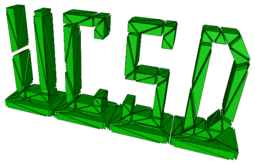| Michael Holst | ||
| https://ccom.ucsd.edu/~mholst/ |
Distinguished Professor of Mathematics and Physics UC San Diego |
|
|
Symposium Honors Herbert Keller
SIAM News, Vol. 28 (December 1995), No. 10, p. 3. By Michael Holst, Ph.D. A symposium in honor of Herbert B. Keller, a professor of applied mathematics at California Institute of Technology and director of the Caltech branch of the Center for Research on Parallel Computation, was held at Caltech's Beckman Institute, June 19--20, 1995. Participants gathered to celebrate Keller's 70th birthday and to recognize his numerous contributions to applied mathematics. Among these are many inovative techniques for solving two-point boundary-value problems, arc-length continuation and other methods for bifurcation problems, as well as the classic numerical analysis textbook he co-authored with Eugene Isaacson. Approximately 60 mathematicians, many of them colleagues and former students of Keller's, presented technical talks (including 12 invited presentations) and exchanged ideas on a wide range of topics. The conference was supported by the Department of Energy, the Center for Research on Parallel Computation, and Caltech's Division of Engineering and Applied Science. Following a continental breakfast, conference organizer Eric Van de Velde, a colleague of Keller's at Caltech since 1986, opened the first day's technical sessions. The first session was chaired by Eugene Isaacson (Courant Institute of Mathematical Sciences, New York University) who introduced the first speaker, Joseph Keller of Stanford University), the guest of honor's brother. Keller discussed the construction of exact nonreflecting boundary conditions for the numerical solution of infinite domain problems in which finite computational domains are introduced and presented some numerical evidence illustrating their effectiveness. Eusebius Doedel (Concordia University) then presented a study of heteroclinic cycles in Josephson junctions, noting at many points the various ways in which Herbert Keller's work had influenced much of his own work and the work of others in the field. The second morning session was chaired by Dan Meiron (Caltech), who recalled his encounters with Keller as a postdoc at Caltech. Meiron introduced Phillip Saffman, who gave an overview of some recent work by Caltech applied mathematicians on bifurcation phenomena in water waves, stressing that much of the work would not have been possible without Keller's contributions. Roland Glowinski (Universities of Houston and Paris) discussed the simulation and control of the molecular docking problem arising in drug design and also made some remarks about the control problem for incompressible Navier--Stokes flows. After lunch at the Athenaeum, the Caltech faculty club, technical sessions resumed. Dale Pullin (Caltech), chair of the first afternoon session, introduced Gene Golub (Stanford), who presented some elegant new techniques for computing the traces and determinants of extremely large matrices, both of which have important applications in chemistry and physics. Thomas Hagstrom (University of New Mexico) then described some techniques based on local approximations of integral operators for the numerical solution of certain classes of partial differential equations. Leading off the second afternoon session, chaired by Rita Meyer-Spasche (Max Planck Institute), was James Keener (University of Utah), who spoke on the electrical behavior of the heart just before and during a heart attack. Heinz-Otto Kreiss (University of California at Los Angeles) concluded the day's technical sessions by discussing various techniques for solving difficult differential equations with multiple time scales. Close to 90 of Keller's friends and colleagues attended the elegant banquet at the Athenaeum in the evening. After dinner, guests were treated to a show entitled "Broadway: The Keller Years." Eric Van de Velde, who shares an interest in Broadway musicals with Herb, had arranged for a local singing troupe to present a selection of Broadway music from 1925 to 1995, including "Oh, What a Beautiful Morning" (Oklahoma!), "All I Ask of You" (Phantom of the Opera), and "Cabaret" (Cabaret). The music concluded with a festive finale, "Be Our Guest" (Beauty and the Beast), during which confetti and streamers were strewn around liberally. Following the show, Joe Keller made a speech that included several quite humorous stories about his brother Herb. The following morning, Warren Ferguson (Southern Methodist University) chaired the first session. The first speaker was William Langford (University of Guelph), who reviewed generalizations of the Hopf bifurcation theorem and presented some new results on mode interactions and resonances. Peter Lax (Courant Institute) then presented some numerical methods for two- and three-dimensional flow problems based on the idea of positivity as a generalization of total variation diminishing (TVD) approaches for one-dimensional problems. After a coffee break, the chair of the second morning session, Victor Pereyra (Weidlinger Associates) introduced Donald Estep (Georgia Institute of Technology), who gave a stimulating talk on the use of adaptive error control for the numerical solution difficult problems. As an illustration of these techniques, he considered numerical evolution of the Lorenz system, long thought to be numerically intractable due to its sensitivity to initial data. Andrew White (Los Alamos National Laboratory) concluded the meeting with a lecture that combined a discussion of some interesting work on crisis forecasting and management with general comments on the direction of research and funding in the mathematical sciences. The latter subject generated quite a bit of reaction from the audience, which spilled out into the Beckman Institute courtyard as the meeting began to break up. Overall, the meeting was both enjoyable and informative. Happy birthday, Herb; we wish you many more! Dr. Michael Holst is a von Karman Instructor of Applied Mathematics at the California Institute of Technology. |
